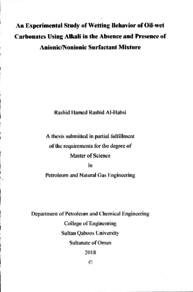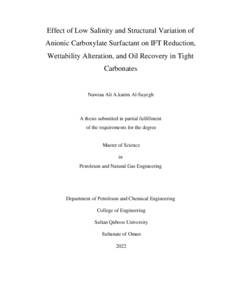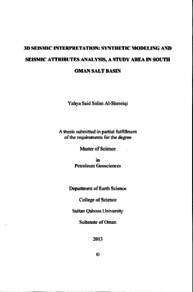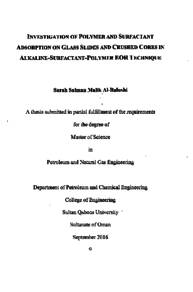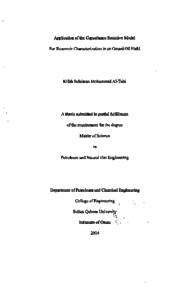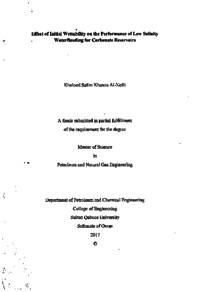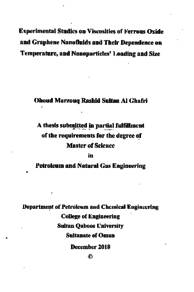وثيقة
An Experimental Study of Wetting Behavior of Oil-wet Carbonates Using Alkali in the Absence and Presence of Anionic//Nonionic Surfactant Mixture
الناشر
Sultan Qaboos University
ميلادي
2018
اللغة
الأنجليزية
الملخص الإنجليزي
Nearly half of all known oil reserves are held in oil-wet, fractured carbonate reservoirs. Wettability alteration towards more water-wet state reduces the capillary barrier, hence improving oil recovery efficiency in such reservoirs. The aim of this work is to investigate the effect of sodium carbonate and sodium metaborate as alkaline solutions in the absence and presence of anionic/nonionic surfactant mixture on the wettability of oil-wet carbonate surfaces. Calcite surfaces were aged in model oil and crude oil and treated with different alkaline solutions. Contact angle and zeta potential measurements were used as a mean to infer wetting conditions before and after treatment. In addition, phase behavior, interfacial tension measurements and core flooding experiments were conducted to examine the ability of these solutions to enhance oil recovery from oil-wet limestone cores.Contact angle measurements for calcite surfaces aged in model oil and crude oil showed oil-wet conditions. Treatment of these surfaces with alkaline solutions showed negligible change in the wettability of surfaces aged in model oil. Sodium carbonate/anionic-nonionic surfactant solution altered the wettability of these surfaces to intermediate to water-wet state. On the other hand, contact angle measurements revealed that both alkalis were effective in changing the wettability of oil-wet calcite surface aged in crude oil. Sodium carbonate in the presence of anionic surfactant altered the wettability towards more water-wet state, whereas for sodium metaborate an opposite effect was observed and an intermediate wetting condition was established.Zeta potential measurements indicated a possible ion exchange between metaborate (BO2) and/or (OH) ions and the adsorbed carboxylate groups on the surface as well as interaction between these ions and the calcium that is attached to thecarboxylate that could lead to the release of carboxylate from these surfaces. For anionic surfactant, surfactant molecules could partially adsorb on the carboxylate groups through hydrophobic-hydrophobic interactions between the tail of the surfactant and the adsorbed carboxylate from the crude oil.Additional oil recovery of around 25 % of original oil in place was achieved using alkaline and alkaline-surfactant mixture (around 11-22% from alkaline alone and 810% from alkaline-surfactant mixture). Wettability alteration toward water-wet state and IFT reduction are contributing factors for additional oil recovery from oil-wet limestone cores. Aging the core samples after injection of the different brine and chemical fronts indicated the importance of time for the crude oil, rock and brine interactions and the consequent additional oil recovery.
الوصف
Thesis
المجموعة
URL المصدر
الملخص العربي
ما يقارب من نصف احتياطي النفط المعروف متواجد في مكامن الصخور الكربونية، والتي غالبا ما تكون متصدعة و ذات خواص ترطيب زيتي تؤدي الى التصاق النفط بسطح الصخر خواص الصخور وترطيب السوائل للأسطح أحد العوامل الرئيسية التي تتحكم في تدفق النفط في المكامن ومن ثم تحسين كفاءة الإنتاج. يهدف هذا البحث لدراسة إمكانية استخدام مواد قلوية مثل كربونات الصوديوم وميتابوريت الصوديوم مع مواد صابونية (Surfactant) ذات الشحنات السالبة والشحنات المتعادلة كأساس لعملية تعزيز الإنتاج وتغيير ترطيب الصخور الكربونية من زيتي الى مائي وكذلك معرفة الآليات التي تؤدي إلى تغير الخواصأجريت عدة اختبارات لقياس قابلية هذه المواد التغيير خواص الصخر من خلال قياس زاوية تلامس السوائل السطح الصخر ( contact angle) , و الشحنة التي تتكون بين السطح الصلب ووسطه السائل المحيط به اذا كانت سالبة او موجبة (Zeta potential) ، و التوتر السطحي (IFT)، وكذلك أجريت اختبارات الحقن للكشف عن قدرة هذه القلويات على تعزيز استخلاص النفط من الحجر الجيري الكربونيكشفت قياسات زوايا التلامس أن كلا من كربونات الصوديوم و میتابوريت الصوديوم كانا فعالين في تغيير قابلية سطح الكالسيت المعالج من سطح ذو ترطيب زيتي إلى سطح ذو ترطيب مائي دون استخدام مواد صابونية خافضة للتوتر السطحي.، وإن كربونات الصوديوم تؤدي بشكل أفضل الى تغيير قابلية الترطيب نحو حالة أكثر رطوبة بالماء، بينما لوحظ تأثير سلبي لمادة ميتابوريت الصوديوم في حالة وجود هذه المواد الصابونية. أظهرت قياسات (zeta potential) إلى تبادل محتمل بين الأيونات (B02) و أو (OH-) ومجموعات الكربوكسيل مما يؤدي إلى إطلاق الكربوكسيل من السطح، كما يمكن أن تتفاعل هذه الأيونات والكالسيوم التي تعلق على مجموعة الكربوكسيل مما يؤدي إلى إزالة أيونات الكالسيوم جنبا إلى جنب مع الكربوكسيلات المرفقة من السطح. بالنسبة للمواد الصابونية الأيونية: في بعض النقاط يمكن للأنشطة السطحية الأيونية أن تتفاعل مع مجموعات الكربوكسيل من خلال التفاعلات الكارهة للماء بين المادة الصابونية و الكربوكسيلأظهرت أختبارات الحقن قدرة هذه القلويات على تعزيز استخلاص النفط من الحجر الجيري ذو الترطيب الزيتي بمعدل انتاج اضافي 25% من هذه المركبات القلوية و المواد الصابونية أضافت المواد القلوية وحدها ما يقارب22 - 11 % إنتاج إضافي مقارنة بانتاج 4--() 1 % من دمج المواد القلوية مع المواد الصابونية. كذلك وجد أن تغير ترطيب الصخر نحو ترطيب ماني و خفض عامل التوتر السطحي (IFT ) هي من العوامل الأساسية التي عززت استخراج النفط من الحجر الكربوني ذو الترطيب الزيتي . كذلك وجد أن فترة غمر الصخر في محاليل الحقن المختلفة مهمة في زيادة إنتاج النفط والتي تؤدي الى تغيير خواص ترطيب الصخر وانتاج النفط المحصور بين الصخور.
قالب العنصر
الرسائل والأطروحات الجامعية

